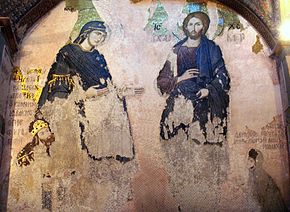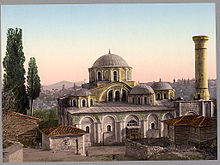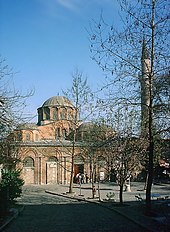Chora Church
The Byzantine Chora Church ( Greek Ἐκκλησία του Ἅγιου Σωτῆρος ἐν τῃ Χώρᾳ , Μουσείο Χώρας ), from the Ottomans to the Kariye Mosque ( Turkish Kariye Museum rededicated), is an in Istanbul district of Fatih situated sacred . The mosaics and frescoes in the style of the palaeological renaissance are among the most important and elaborate sacral cycles in the world. From its construction at the end of the 11th century to the early 16th century, the sacred building was an Orthodox church, was then used as a mosque , after extensive restoration it was converted into the Kariye Museum ( Kariye Müzesi in Turkish ) in 1948 and again for Islamic prayer in 2020 open.
history
As early as the 5th century, outside the walls that Constantine the Great had built around his new capital in the 4th century, there was a church called Chora, which means “land, surrounding area”. When Theodosius II moved the defensive wall , the so-called Theodosian Land Wall , further west, the name remained, although the building complex was now included in the actual urban area. The name has also gained symbolic importance since inscriptions in the church refer to Christ as the “land of the living” and Mary as the “land of the infinite”.
From 1077 to 1081 Maria Doukaina, the mother-in-law of Emperor Alexios I , donated the church, which was probably a four-pillar church, a design that was very popular at the time. After a partial collapse in the early 12th century, the church was fundamentally renovated and extensively redesigned by the founder's grandson, Isaak Komnenos , the third son of Alexios I. But the Chora church as we know it today was not built until the third construction phase, two centuries later. Theodoros Metochites , the chancellor and first treasurer under Andronikos II. Palaiologos , had the dilapidated church completely restored and decorated with extensive picture cycles in the years 1315 to 1321. The mosaics are the most important example of the renaissance of the palaeologists .
About half a century after Constantinople was conquered by the Ottomans , the Chora Church, which had previously served the Christian rite, was converted into a mosque by Atık Ali Paşa, Grand Vizier Bāyezīds II , and renamed Kariye Camii. The mosaics were plastered or whitewashed because of the ban on images in Islam . Others broke off the walls in the frequent earthquakes .
Since 1948, Thomas Whittemore and Paul A. Underwood have organized a restoration program sponsored first by the Byzantine Institute of America and later by the Dumbarton Oaks Center for Byzantine Studies . The Turkish automobile club TTOK has renovated an entire complex of wooden houses from the Ottoman era around the Kariye Mosque .
After the Supreme Court of Turkey granted the request to convert it into a mosque in November 2019, it was used as an Islamic place of worship following a decree issued by Recep Tayyip Erdoğan in August 2020 .
Theodoros Metochites presents the enthroned Christ with a model of the church
construction
The church is preceded by an eso- and an exonarthex , on the southern side there is a side chapel ( parekklesion ), on the left a two-story gallery. A dome rests above the central space, which was renewed in its current form by the Ottomans.

decoration
The mosaics and frescoes are the most important surviving Byzantine sculptures both qualitatively and in number. If there are differences in detail, their liveliness and realism point to Italian frescoes of the early Renaissance. They have little in common with traditional, strictly stylized Byzantine art. The graceful moving people give the representations incomparable lightness and elegance, which is also underlined by the fresh coloring. The wide variety of biblical topics also gives an impression of the creative power of Byzantine masters. The joy of storytelling and the richness of detail of the mosaics are characteristic. Their leitmotifs are the incarnation of God (the incarnation) and the associated redemption of human beings. The second coming of Christ as the central motif of the frescoes in the burial chapel rounds off this concept.
The mosaics

The mosaics in the church follow a strict iconographic order. As you enter the Chora church, your gaze falls on the representation of Christ Pantocrator above the portal to the inner narthex. Behind it, across from the main entrance, appears the Virgin Mary: The new foundation was thus consecrated to Christ and Mary. After passing through the outer narthex one comes across the donor mosaic, which shows Theodoros Metochites kneeling as he offers a model of his church to Christ. Two mosaic icons Peter and Paul flank the passage. The south dome in front of it shows Christ Pantocrator and the genealogy of Christ, the north dome shows Mary and her ancestors. The cycle of originally 20 scenes with depictions from the legend of the life of Mary, which was very popular in the Middle Ages, begins in the vault below the dome . The cycle of images in the outer narthex begins with Jesus' childhood and continues into the inner narthex with depictions of the public ministry of Christ. Portraits of saints and the mosaic of the dying virgin in the nave complete the overall picture.
Peter mosaic
The frescoes
The frescoes in the south side chapel ( Parekklesion ) were the last commission of the Chancellor Theodoros Metochites and probably date from the years 1320 and 1321. The image program is typical for depictions in a burial chapel: They are themes of the resurrection and the Last Judgment . The paintings above the ledge depict Christ as judge of the world, heaven and hell and Mary as mediator between heaven and earth. In the conche of the apse , the resurrection of Jesus Christ (Greek: Anastasis) can be seen. In the center is Christ, who has just blown up the rocks and gates of hell, with Satan in chains at his feet. With his right hand he pulls Adam out of the grave, with the left he frees Eve . Behind Adam are John the Baptist , David and Solomon , Abel and a group of the righteous in Eve's tomb . The four graves in the chapel are in deep niches. Originally there were sarcophagi there. Traces of the former mosaics and frescoes can still be seen above.
The tomb of Theodoros Metochites
An elaborately chiseled and decorated archivolt adorns the grave at the northern end of the chapel. The name inscription has been lost, but it is certain that it is the grave of the church's founder, Theodoros Metochites . He was one of the most important personalities of his time, a typical representative of the palaeological renaissance: he was a diplomat, high government official, theologian, philosopher, historian, astronomer, poet and patron of the arts. He is considered to be one of the initiators of the renaissance of palaeologists. After the coup by Andronikos III. (1328-1341) fell out of favor with Metochites and the other leaders of the old regime . They lost their property and were exiled . Only shortly before the end of his life was Metochites allowed to return to the city and retired to the Chora monastery, where he died on May 13, 1331.
literature
- Paul A. Underwood : The Kariye Djami . 3 volumes, New York 1966.
- Robert Ousterhout : The architecture of the Kariye Camii in Istanbul. Dumbarton Oaks, Washington 1987, ISBN 0-88402-165-2 .
- Holger A. Klein (Ed.): Restoring Byzantium. The Kariye Camii in Istanbul and the Byzantine Institute restoration. Miriam and Ira D. Wallach Art Gallery, Columbia University, New York 2004, ISBN 1-884919-15-4 .
- Holger A. Klein, Robert Ousterhout, Brigitte Pitarakis (eds.): Kariye. From Theodore Metochites to Thomas Whittemore. One Monument - Two Monumental Personalities . Istanbul 2007.
- Holger A. Klein, Robert Ousterhout, Brigitte Pitarakis (Eds.): The Kariye Camii Reconsidered . Istanbul 2011.
Web links
Individual evidence
- ↑ DER SPIEGEL: Erdogan is converting Istanbul's Chora Museum into a mosque - DER SPIEGEL - politics. Accessed August 21, 2020 .
Coordinates: 41 ° 1 ′ 52 ″ N , 28 ° 56 ′ 21 ″ E





















